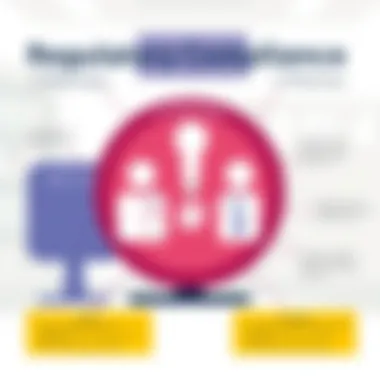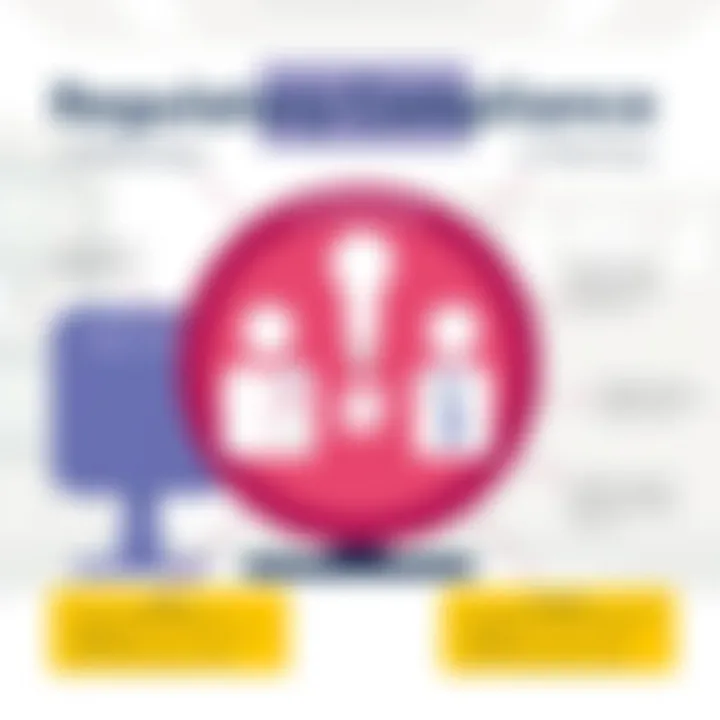Retail Pharmacy Computer Systems: Enhancing Efficiency


Intro
In an era where the digital landscape is reshaping industries, retail pharmacy computer systems stand at the forefront of innovation in healthcare. These systems are not just software programs; they are essential tools that streamline operations, safeguard patient data, and ensure adherence to evolving regulations. Many pharmacy professionals and business owners recognize the profound impact these systems have on their day-to-day operations, yet few fully understand the scope of their functionalities or the nuances involved in selecting the right solution. This article aims to bridge that gap, providing a detailed examination of the software landscape that facilitates pharmacy operations.
Software Category Overview
Purpose and Importance
Retail pharmacy computer systems serve as the backbone of pharmacy management, encompassing a variety of functionalities essential to effective operations. At their core, these systems facilitate the processing of prescriptions, manage inventory, and support billing and insurance claims. However, their utility extends beyond mere transaction execution.
- Operational Efficiency: By automating routine tasks, these systems enable pharmacies to operate more smoothly and focus on what truly matters—patient care.
- Patient Safety: These systems play a critical role in ensuring that prescriptions are accurately filled, thereby preventing medication errors that could jeopardize patient safety.
- Regulatory Compliance: Compliance with guidelines from entities like the FDA or CMS requires careful documentation and reporting, all of which can be efficiently managed through these systems.
In today’s competitive landscape, the significance of having a robust pharmacy computer system cannot be overstated. As more patients demand quick and error-free service, a well-implemented system can distinguish pharmacies from their competitors.
Current Trends in the Software Category
The market for retail pharmacy computer systems is rapidly evolving, shaped by technological advancements and shifting consumer preferences. Some notable trends include:
- Cloud-Based Solutions: Many pharmacies are migrating to cloud-based platforms, offering scalability and enhancing collaborative functionalities.
- Artificial Intelligence: AI integration is growing, assisting pharmacies in predicting inventory needs and optimizing order processes based on historical data.
- Telepharmacy: With the rise of telehealth, systems that can support remote consultations and pharmacy services are becoming increasingly valuable.
Understanding these trends helps stakeholders make informed choices to remain competitive in an ever-changing market.
Data-Driven Analysis
Metrics and Criteria for Evaluation
When assessing retail pharmacy computer systems, specific metrics must be employed to gauge effectiveness. Some common criteria include:
- User Experience: How intuitive is the system for pharmacy staff? A steep learning curve could hinder adoption.
- Integration Capabilities: Does the system easily integrate with existing tools or workflows?
- Data Security: Given the sensitive nature of healthcare data, the system's security protocols are paramount.
- Cost-Benefit Analysis: Understanding the return on investment is essential for determining long-term viability.
By analyzing these metrics, decision-makers can pinpoint systems that align with their operational goals.
Comparative Data on Leading Software Solutions
As the market hosts a plethora of options, it is crucial to compare leading solutions based on their functionalities and user reviews. For example:
- Cerner Retail: Known for its comprehensive suite that caters to pharmacy management and patient data integration.
- Epic Systems: Often praised for its user-friendly interface and strong customer support initiatives.
- McKesson Pharmacy Systems: Offers specialized services tailored for high-volume pharmacies, enhancing workflow efficiency.
The right choice often hinges on specific needs rather than one-size-fits-all solutions.
Ultimately, selecting retail pharmacy computer systems is more than just a technical decision; it reflects a commitment to improving healthcare delivery systems.
For more on pharmacy technology trends, check out American Pharmacy Association or NCPDP for further insights and resources.
Intro to Retail Pharmacy Computer Systems
In today’s fast-paced world of healthcare, retail pharmacy computer systems have emerged as essential tools for ensuring effective manageability and enhanced care delivery. These systems do more than just facilitate basic transactions; they furnish pharmacies with a platform that streamlines operations, optimizes inventory, and ultimately elevates the patient experience.
As the healthcare industry has come to rely increasingly on technology, understanding the role and functionality of these systems becomes paramount for pharmacy professionals and business stakeholders alike. From small independent pharmacies to expansive chain operations, the benefits of implementing robust computer systems are manifold, aiding not only in operational efficiency but also in regulatory compliance and patient satisfaction.
Definition and Importance
Retail pharmacy computer systems encompass a suite of technologies designed to support the various operational needs of pharmacies. These systems include functionalities for prescription management, inventory control, patient information management, and billing, to name a few. The integration of these elements is vital. Without it, pharmacies risk operational inefficiencies, which can impede customer service and even lead to critical medication errors.
The importance of these systems cannot be overstated: they serve to enhance accuracy in prescription filling, ensure adherence to regulatory mandates, and provide valuable data for decision-making. For instance, when a customer walks into a pharmacy, the system can pull up their medical history, allergies, and past prescriptions with just a few clicks, allowing pharmacists to make informed recommendations. Such efficiencies not only protect the patient’s health but also foster trust in healthcare practices.
Evolution of Pharmacy Technology
Pharmacy technology hasn't always been what it is today. In the not-so-distant past, pharmacies relied heavily on manual processes for prescription management. Think of it—handwritten scripts, paper charts overflowing with patient records, and a hefty stack of invoices that took time to manage. Over the years, however, the landscape has drastically transformed.
The introduction of personal computers in the 1980s began the shift towards automation, but it wasn't until the advent of internet connectivity that the real revolution took place. The digital age ushered in a plethora of software solutions that allow for real-time inventory tracking, e-prescribing, and even telepharmacy services. Today’s advanced systems leverage artificial intelligence to predict inventory needs based on historical data, thus enabling pharmacies to stay ahead of the game.
The transformation is ongoing, with cloud-based solutions now on the horizon, promising greater scalability and flexibility. Pharmacists today find themselves in a tech-centric environment where data analytics and patient care go hand in hand, marking an evolutionary leap from the days of manual record-keeping.
In summary, as we delve deeper into retail pharmacy computer systems, we uncover their multifaceted benefits and intricate technologies that shape not only the operational framework of pharmacies but, more importantly, the health outcomes of patients.
"In an age where technology continues to advance, staying behind the curve is simply not an option for retail pharmacies. The future demands integration, adaptability, and a keen understanding of how these systems work to elevate patient care." - Industry Expert
The discussions to follow in this article will critically analyze the various types, key features, and more about these invaluable systems, providing a roadmap for understanding their full impact in the retail pharmacy landscape.
Types of Retail Pharmacy Computer Systems
Understanding the various types of retail pharmacy computer systems is critical for any pharmacy looking to streamline operations and enhance patient care. Each system comes with its own unique set of functionalities tailored to meet specific needs in the pharmacy landscape. Knowing these systems not only aids in decision-making but helps pharmacists align technology with their business objectives, ultimately leading to improved workflow and better patient outcomes.
Prescription Management Systems


Prescription management systems play a pivotal role in retail pharmacies. These systems are designed to manage the entire lifecycle of prescriptions—from creation and processing to dispensing and monitoring. A key benefit of these systems is the reduction of errors, which can occur during manual entry or processing. With features like electronic prescriptions, pharmacies can ensure a smoother experience for both pharmacists and patients.
Moreover, prescription management systems often integrate with health records, allowing pharmacists instant access to patient medication history. This has a profound impact not only on patient safety but also on adherence to prescribed therapies. Time spent on data entry can be minimized, making way for clinicians to focus more on patient consultations rather than administrative tasks.
"The automation involved in prescription management drastically cuts down on the human error factor, which is critical in a healthcare setting."
Inventory Management Systems
Inventory management systems are indispensable tools in the pharmacy environment. A well-functioning inventory system helps track medication stock levels, expiration dates, and reordering processes. This ensures that pharmacists never run out of essential medications and can respond promptly to patient needs.
In addition, these systems can alert pharmacy staff to medications that are close to expiration, thereby minimizing waste and loss by enabling timely procurement of fresh stock. Reports generated from the inventory management systems can provide insights into usage patterns, allowing pharmacies to optimize their purchasing strategies and maintain an ideal stock level.
Effective inventory management also leads to improved cost efficiency, as it helps pharmacies align their stock with demand.
POS and Billing Systems
A robust Point of Sale (POS) and billing system is the backbone of any retail pharmacy operation. These systems not only facilitate financial transactions but also integrate seamlessly with other pharmacy systems to ensure the health of the business. An efficient POS system allows for quick and accurate checkouts, thereby enhancing customer service by reducing wait times.
Moreover, modern POS systems often include features like loyalty programs and promotions, which can drive sales and enhance customer retention. They can also generate comprehensive reports that provide insights into sales trends and peak purchasing times. Good financial oversight through these systems helps in understanding profitability and adjusting strategies accordingly.
Patient Management Systems
Patient management systems are designed to enhance the relationship between pharmacies and their patients. These systems focus on maintaining patient records, monitoring health progress, and ensuring medication adherence. With features such as appointment scheduling, reminders for medication refills, and health questionnaires, these systems facilitate better communication.
By leveraging patient management systems, pharmacists can provide personalized care that addresses the unique medication needs of each individual. This not only improves the health outcomes for patients but can help in developing a loyal customer base that appreciates the attentive services provided. Analysis tools embedded within these systems can also assist in evaluating the effectiveness of treatment plans, leading to further improvements in care delivery.
With the advancement in technology, pharmacies are beginning to recognize the significance of integrated systems that encompass all these functionalities. The interconnectedness of these various systems can create a harmonious environment where data flows seamlessly, ultimately supporting the overarching goal of enhancing patient care and operational efficiency.
Key Features of Pharmacy Computer Systems
The landscape of retail pharmacy computer systems is continually evolving, making it imperative for pharmacies to leverage sophisticated features that enhance operations. The significance of key features cannot be understated, as they form the backbone of efficient pharmacy management, support regulatory compliance, and foster improved patient care. Understanding these features is crucial for stakeholders who aim to optimize their pharmacy's performance.
User Interfaces and Usability
When it comes to pharmacy computer systems, user interfaces play a pivotal role. A pharmacy system with an intuitive interface can drastically reduce the learning curve, facilitating smoother adaptation by staff members. This is critical, especially in busy environments where time is often of the essence. An effective user interface allows pharmacists to navigate quickly between tasks, from processing prescriptions to checking inventory levels.
Operating a system should feel intuitive, like slipping on a favorite pair of shoes. If the software confuses its users, it can lead to mistakes that may affect patient safety or result in wasted time. Overall, usability elements like customizable dashboards and shortcuts for frequent tasks can make daily operations less cumbersome and more efficient.
Data Security and Compliance
In today's digital age, data security stands as a pillar of pharmacy systems. Pharmacies handle sensitive patient information that is protected under various regulations like HIPAA. Failure to secure this data could lead not only to legal repercussions but also to a loss of trust from patients.
Pharmacy systems need to boast features that encrypt data both at rest and in transit, ensuring it can only be accessed by authorized personnel. Regular audits and compliance checks should be integrated features, allowing pharmacies to remain vigilant against potential security threats.
Choosing a system that prioritizes security and compliance is non-negotiable for any pharmacy looking to sustain operations long-term in a heavily regulated environment.
Reporting Tools and Analytics
The role of reporting tools and analytics in pharmacy computer systems cannot be overlooked. With the right analytical features, a pharmacy can turn mundane data into actionable insights. How are sales trends behaving? Are certain medications flying off the shelves while others gather dust? Monitoring such metrics helps pharmacies make informed decisions about inventory management and patient care.
- Advanced analytics can help in predicting patient needs, suggesting which products to stock up on based on historical data.
- Reporting tools can also assist with financial assessments, shedding light on profit margins and operational inefficiencies.
- These insights give pharmacy owners a clearer view of their business landscape, empowering them to tweak their services based on actual performance metrics.
In the world of retail pharmacy, knowledge isn’t just power; it’s profit.
All in all, key features within pharmacy computer systems shape their ability to function effectively in a fast-paced healthcare realm. By prioritizing usability, data security, and robust reporting, pharmacies can navigate the complexities of modern patient care while ensuring compliance and operational efficiency.
Implementation Challenges in Retail Pharmacy Systems
In the fast-paced world of retail pharmacy, adopting computer systems is no small feat. These systems can indeed streamline operations, safeguard patient data, and ensure compliance with stringent regulations. However, there are some bumps along the road to successful implementation, which is where this section comes into play. Understanding the challenges faced during this process is vital not only for mitigating risks but also for maximizing the benefits derived from these sophisticated tools.
The underlying issues can often be broken down into three main areas: cost considerations, training related to user adoption, and the integration with existing systems. Each of these carries its own weight in significance and needs careful attention to navigate through the complexities of deployment.
Cost Considerations
When it comes to the financial aspect of introducing pharmacy computer systems, the stakes are high. Estimating the total cost of ownership (TCO) can be as slippery as a bar of soap. It's more than just the initial purchase price.
- Licensing Fees: Many companies charge recurring fees for software usage, which can accumulate over time, especially if your pharmacy has multiple locations.
- Hardware Costs: In addition to the software, reliable hardware is a must. This often includes servers, computers, and peripherals, all of which can add up.
- Maintenance and Upgrades: Keeping systems up to date is crucial. Costs associated with ongoing maintenance or necessary upgrades can take a hefty bite out of your budget.
The need to perform a cost-benefit analysis emerges as essential. This type of analysis not only sheds light on the potential financial return but also aids in determining if the system would improve operational efficiency enough to justify its expenses.
Training and User Adoption
Implementing new tech without proper training is like trying to drive a car without lessons; it's a recipe for disaster. To avoid driving into pitfalls, comprehensive training programs must be designed.
- Tailored Training: Each user has unique needs when it comes to understanding software applications. A one-size-fits-all training program rarely hits the mark, making customized approaches a necessity.
- Ongoing Support: Once training sessions are completed, the lack of support can lead to frustration. Providing ongoing assistence can ease the transition phase, paving the way for smoother adoption.
- User Feedback: Engaging end-users in the training process allows for real-time feedback. This input can help refine the training methodology, making it more effective as well.


For any pharmacy system to function optimally, it is imperative that all staff members feel comfortable using it. When users understand how to navigate the system, they are likely to use it effectively, thereby improving overall efficiency in daily operations.
Integration with Existing Systems
Many pharmacies are not starting from scratch; they have existing systems already in place. Integrating new pharmacy computer systems with what’s already running can be as complicated as putting together a jigsaw puzzle without the picture.
- Data Migration Issues: Transferring data from older systems can often lead to errors, inaccuracies, or complete data loss. A meticulous approach to data transfer is crucial.
- System Compatibility: The compatibility of new systems with old analytics tools or databases needs thorough evaluation. If the two systems can't 'talk' to each other, it can create operational headaches.
- Workflow Disruption: Implementing new technology might temporarily disrupt workflows, which can lead to frustration among staff and potential errors in order fulfillment.
It is crucial for pharmacy administrators to actively plan for these integration challenges. By identifying potential roadblocks early on, strategies can be put in place to cushion the blow, ensuring that the transition is as smooth as possible.
"In every challenge, there lies an opportunity to enhance and evolve."
As the pharmacy landscape continues to evolve, so too must the systems that support it. Recognizing and confronting the implementation challenges becomes a crucial aspect of achieving long-term success in retail pharmacy.
Regulatory Compliance and Standards
Regulatory compliance in the landscape of retail pharmacy computer systems is crucial, as it directly impacts the operations, patient safety, and legal obligations of pharmacy practice. These regulations serve as a framework ensuring that pharmacies operate within the boundaries of the law while providing safe and effective care to patients. Adhering to these standards is not merely a formality; it helps build trust with clients and regulatory bodies alike, ultimately contributing to the overall sustainability and success of pharmacy businesses.
A pharmacy that champions compliance sets itself up for success by adopting industry standards that dictate how patient information is handled and how medications are managed. This involves constant vigilance and an understanding of how regulations evolve. Compliance impacts everything from software selection to operational protocols, which means pharmacies must stay apprised of the latest developments in the sector.
"In the pharmacy world, compliance isn’t just a box to tick; it’s a commitment to safeguarding patient health and maintaining operational integrity."
HIPAA Considerations
The Health Insurance Portability and Accountability Act (HIPAA) is a cornerstone of regulatory compliance within the healthcare sector, including retail pharmacies. AHIPAA ensures that personal health information (PHI) remains confidential and protected from unauthorized access. For pharmacies, this translates to adopting computer systems that include robust security measures for data protection, ensuring compliance with these federal standards.
Pharmacies must ensure their software providers integrate necessary security features such as:
- Access Control: Restricting access to patient data to authorized personnel only.
- Data Encryption: Protecting data during transmission and storage to prevent breaches.
- Audit Logs: Keeping track of all access to patient data to identify potential issues.
Failing to comply with HIPAA can lead to hefty fines and damage to a pharmacy's reputation. Therefore, pharmacies must choose systems that not only comply with HIPAA but also adapt to future changes in data protection laws. The stakes are high, particularly considering the evolving landscape of cyber threats.
FDA Regulations
The Food and Drug Administration (FDA) also plays a crucial role in the realm of pharmacy computer systems. Regulations from the FDA govern the management of prescriptions, medical records, and even the efficacy of pharmaceutical products. Pharmacies using computer systems must ensure that their solutions facilitate compliance with FDA regulations pertaining to medication dispensing, tracking, and reporting.
Some key regulations include:
- Prescription Data Management: Systems must track and store prescription information accurately.
- Reporting Requirements: Pharmacies are often required to compile and report data regarding medication safety and efficacy.
- Software Validation: Any software used must undergo a validation process to confirm its reliability and safety in handling pharmaceutical data.
Ultimately, understanding and adhering to FDA regulations not only fortifies a pharmacy’s legal standing but also elevates its operational efficiency and patient trust. Pharmacies that take the time to familiarize themselves with and implement these regulations will find themselves at a significant advantage in a crowded marketplace.
Future Trends in Pharmacy Computer Systems
The landscape of retail pharmacy computer systems is ever-shifting. As technology advances, various trends emerge that aim to reshape how pharmacies operate. These future trends are not just innovations; they are essential aspects that can significantly influence efficiency and patient care. Understanding these trends gives pharmacy professionals a competitive edge in a rapidly evolving market.
Artificial Intelligence and Machine Learning Integration
Artificial intelligence (AI) and machine learning (ML) are not mere buzzwords; they are vital tools that can drive efficiency in pharmacy operations. For instance, integrated AI algorithms can analyze large datasets to predict medication needs, reducing the chances of stockouts or overstock situations. It's like having a crystal ball that helps managers make informed decisions about inventory. Some systems use ML to optimize workflows, predicting peak hours and scheduling staff accordingly. This reduces wait times for patients—a critical improvement in any pharmacy.
Furthermore, AI can assist in enhancing patient safety. For example, machine learning can flag potential drug interactions by analyzing patient histories and prescriptions. This not only elevates the quality of care provided but ensures compliance with safety protocols, ultimately protecting pharmacies from liability. In essence, adopting AI and ML technologies can revolutionize how pharmacies manage their resources and serve their customers.
Cloud-based Solutions
Cloud computing has transformed various sectors, and retail pharmacy is no exception. Utilizing cloud-based solutions offers flexibility and scalability that traditional systems often lack. For smaller independent pharmacies grappling with budget constraints, moving to the cloud can significantly reduce upfront costs associated with hardware and maintenance.
The benefits are numerous:
- Real-time Data Access: Staff can access crucial data from anywhere, whether they're inside the pharmacy or at a remote location. This increases operational agility, especially in emergencies.
- Collaboration: Cloud systems enable better communication among pharmacy staff and across multiple branches, fostering a cohesive workflow.
- Automatic Updates: Many cloud-based solutions automatically update to the latest features and security patches without disturbing daily operations.
Despite these perks, cloud solutions come with their own set of challenges. One major concern is data security. Pharmacies must ensure that the cloud provider complies with HIPAA regulations to protect patient information. However, the pros of cloud-based pharmacy systems, especially regarding efficiency and flexibility, often outweigh the cons.
In summary, the future of pharmacy computer systems lies in leveraging AI and embracing cloud technology—two trends that promise to enhance efficiency while better serving patient needs. Understanding and adapting these trends could position pharmacy businesses favorably in a competitive environment, ensuring a smooth transition into a tech-driven future.
The Role of Data Analytics in Pharmacy Systems
Data analytics has increasingly become the bedrock of operational advancement in various sectors, and retail pharmacy is no exception. By leveraging data analytics, pharmacies can unearth valuable insights from myriad data points, ultimately guiding strategic decision-making processes. The significance of data analytics in pharmacy systems cannot be overstated. Here, we’ll explore how it reshapes both inventory management and patient outcomes, painting a picture of a more efficient pharmacy landscape.
Improving Inventory Management
Effective inventory management is crucial for any retail pharmacy aiming to maintain operational efficiency and reduce costs. Data analytics plays a pivotal role in optimizing stock levels, minimizing wastage, and ensuring that pharmacies can meet customer demand without overstocking items that might expire.
- Predictive Analytics: By using algorithms to analyze historical sales data, pharmacies can forecast when specific medications will be in high demand based on seasons, trends, or patient demographics. This predictive approach allows pharmacists to stock appropriately, thereby reducing the chances of running out of critical medication.
- Real-time Monitoring: Many modern pharmacy systems now integrate real-time data analytics, enabling tracking of inventory levels instantaneously. This feature alerts pharmacy staff to reorder stock before running low, ensuring that the shelves are always stocked with essential medications.
- Cost Optimization: Data analytics also assists in identifying slow-moving products, allowing pharmacies to minimize holding costs while keeping capital available for items that generate higher sales volumes. Simplifying the inventory through data can lead to a leaner stock and improved cash flow.
Utilizing data analytics is not just beneficial; it’s a game changer for inventory management. Pharmacies that effectively deploy these systems can achieve unprecedented operational efficiency.


Enhancing Patient Outcomes
At the heart of every pharmacy's operation is the commitment to improve patient outcomes. Harnessing data analytics facilitates this goal by providing deep insights into patient behavior, treatment efficacy, and medication adherence.
- Personalized Care: Data analytics allows pharmacies to analyze demographic data, which helps in tailoring medication plans that meet specific patient needs. By understanding patterns, pharmacists can offer personalized consultations that educate patients on their medications, enhancing adherence.
- Identifying Gaps in Care: By scrutinizing data on patient fills and refills, pharmacies can spot trends that suggest patients might not be adhering to their medication regimens. This leads to proactive outreach initiatives to encourage patients to maintain their treatments, ultimately improving health outcomes.
- Outcomes Tracking: With robust analytics systems, pharmacists can track treatment outcomes across diverse patient populations. This analysis can provide insights about the effectiveness of treatments and identify the most effective medications, leading to improved protocols and more positive patient results.
In summary, the role of data analytics in pharmacy systems transcends mere number-crunching; it is about making informed decisions that boost efficiency and health outcomes. As the pharmacy landscape continues to evolve, those who embrace analytics will find themselves at the forefront of patient care and operational excellence.
For more information on the impact of data analytics in healthcare, visit Wikipedia or HealthIT.gov.
Selecting the Right Pharmacy Computer System
Choosing the right pharmacy computer system is essential in today’s fast-paced retail pharmacy environment. It's not just about the technology, but how it aligns with the pharmacy's operational goals and the specific needs of the staff and patients. With numerous options available, making an informed decision can greatly impact efficiency, patient safety, and overall pharmacy success.
Assessing Business Needs
Before diving into any vendor comparisons or software features, it’s crucial to first assess the pharmacy's business needs carefully. Understanding what you require from a pharmacy computer system is the starting point. Here are some aspects to consider:
- Workflow Analysis: Identify current workflows in your pharmacy. Are there bottlenecks? How does staff interact with the existing system? Knowing the pain points helps in seeking solutions.
- Customer Service: Consider patient interaction. For instance, how professional is the prescription management process? A system with robust customer interface capabilities might be necessary to improve the patient experience.
- Compliance and Regulation Needs: Establish the legal and regulatory requirements your pharmacy must follow. You don’t want a system that will be a headache during audits.
- Budget Constraints: Determine a budget that aligns with your pharmacy's financial capabilities. Sometimes, costlier systems come with features that can save money in the long run; evaluate this when planning.
By taking the time to grasp these essentials, pharmacy operators can specify criteria that directly reflect their operational unique characteristics, ensuring a smoother transition to a new system.
Comparing Software Vendors
Once business needs are clearly defined, it's time to compare software vendors. This step is crucial as not all systems are created equal. Here’s what to look out for when shopping around:
- Feature Set: Every pharmacy runs differently. Compare features and functionalities of different systems. A robust prescription management system may not make sense if focusing more on patient management is the priority.
- User Feedback and Reviews: Seek first-hand accounts and reviews from current users of the software. Websites like Reddit or pharmacy-focused forums can provide insights into user experiences.
- Vendor Support and Training: Evaluate the quality of support offered by the vendor. Does the vendor offer necessary training? Are they readily available for ongoing support? A lack of support could leave staff stranded during critical moments.
- Customization Options: Look into how flexible a vendor is with the system they offer. Customization can be vital for pharmacies needing to tailor their software to specific workflows or functions.
- Integration with Other Systems: Confirm that the software can integrate smoothly into existing systems. Seamless integration saves time and reduces complications.
To sum up, comparing software vendors isn’t just about scrutinizing features—it’s about understanding how these systems fit into your distinct pharmacy setting. A careful selection can lead to improved efficiency and patient care, establishing a solid foundation for the pharmacy’s future success.
"Selecting the right system can save headaches down the road, making life easier for both staff and patients."
Case Studies of Successful Implementations
In the world of retail pharmacy, practical examples are invaluable. They provide aspiring pharmacy owners and decision-makers a tangible sense of what success can look like. By analyzing case studies of successful implementations of pharmacy computer systems, stakeholders can glean critical insights about best practices, the kind of impact these systems have on daily operations, and how they can drive improved patient care and business efficiency. Such examples not only illuminate the successes possible with these systems, but also highlight potential pitfalls and areas requiring caution.
Drawing lessons from both small independent operations and larger chain pharmacies enables pharmacy professionals to apply these insights to their unique contexts, thereby making informed decisions when selecting and implementing computer systems.
Small Independent Pharmacies
Small independent pharmacies often face unique challenges due to limited resources and competition from larger chains. One notable case is that of a community pharmacy in Springfield that decided to implement a tailored Prescription Management System. By adopting this technology, the pharmacy integrated their POS, inventory management, and patient management into a cohesive solution. As a result, the efficiency of their operations dramatically improved.
- Benefits realized in this case include:
- Increased Efficiency: Filling prescriptions became quicker and more accurate, resulting in reduced wait times for patients.
- Enhanced Customer Insights: By analyzing patient data, the pharmacy offered personalized services, including medication adherence programs that resulted in improved patient health outcomes.
- Cost Savings: Streamlined processes led to a reduction in overhead costs, allowing the pharmacy to reinvest savings into better services and community initiatives.
This example illustrates that even small players can harness advanced technology for substantial gains, all while maintaining a personal connection with their customers.
Large Chain Pharmacies
In contrast, larger chains may have more extensive resources, yet also face the challenge of maintaining consistent services across numerous locations. A landmark case is the national retail pharmacy chain, Walgreens. They embarked on a large-scale initiative to integrate AI-driven Analytics Tools within their existing systems.
- Impacts of this initiative included:
- Data-Driven Decisions: By leveraging analytics to monitor inventory levels and customer trends, Walgreens significantly reduced stockouts and wasted inventory.
- Improved Customer Experience: The system allowed for real-time customer feedback, enabling them to fine-tune their offerings based on direct consumer input.
- Regulatory Compliance: Enhanced reporting tools ensured compliance with the ever-evolving regulatory landscape much more effectively.
The collective success from this rollout across thousands of locations not only underscored the scalability of pharmacy computer systems but also highlighted the importance of data analytics in fostering both business growth and customer loyalty.
"Lessons from these case studies reveal that tailored systems are about more than just technology; they are about bettering the pharmacy landscape as a whole."
In summary, successful implementations in both small and large pharmacy settings exemplify the transformative potential of pharmacy computer systems. They illustrate that no matter the size of the establishment, leveraging appropriate technologies can enhance operational efficiency and ultimately improve outcomes for patients.
Culmination
In wrapping up our exploration of retail pharmacy computer systems, it’s crucial to understand the pivotal role these systems play in the healthcare landscape. Their importance cannot be overstated; they not only streamline pharmacy operations but significantly enhance patient care and ensure regulatory compliance. As pharmacies navigate through the complexities of managing medications, patient records, and inventory, the right computer system becomes a lifeline.
Summary of Key Points
Throughout this article, we have touched on several vital aspects:
- Types of Systems: Different pharmacy systems like prescription management, inventory management, and POS systems serve distinct functions.
- Key Features: Strong user interfaces, data security protocols, and reporting abilities are what differentiate effective systems from their lesser counterparts.
- Implementation Challenges: Cost considerations and training remain significant hurdles for many pharmacies, showing that a great system means little if it’s not adopted properly.
- Emerging Trends: Innovations such as artificial intelligence and cloud technology signal a shift in how pharmacies operate, ushering in enhanced capabilities for data analytics and operational efficiency.
All these elements underscore the necessity for pharmacies to carefully evaluate their computer systems not merely as tools, but as integral assets that can support and drive their operational strategies.
The Future of Retail Pharmacy Systems
Looking ahead, the future of retail pharmacy systems seems bright but also challenging. There's a noticeable move towards integrating cutting-edge technologies like artificial intelligence and machine learning to automate routine tasks, allowing pharmacists to focus more on patient interaction rather than paperwork. More sophisticated data analytics tools will enable pharmacies to better predict inventory needs and manage stock levels, reducing waste and enhancing service.
Cloud-based solutions are also increasingly popular. They allow for scalability and flexibility, ensuring that pharmacies of all sizes can find a system that meets their unique needs without breaking the bank. However, with these advancements come challenges associated with data security. As the reliance on technology grows, safeguarding sensitive patient information must be priority number one.
In summary, while the landscape of retail pharmacy computer systems is constantly changing and evolving, the foundational benefits of improving operational efficiency, enhancing patient care, and ensuring compliance remain central to their value. Pharmacies willing to adapt and embrace these changes stand to gain immensely in both their service delivery and customer trust.







